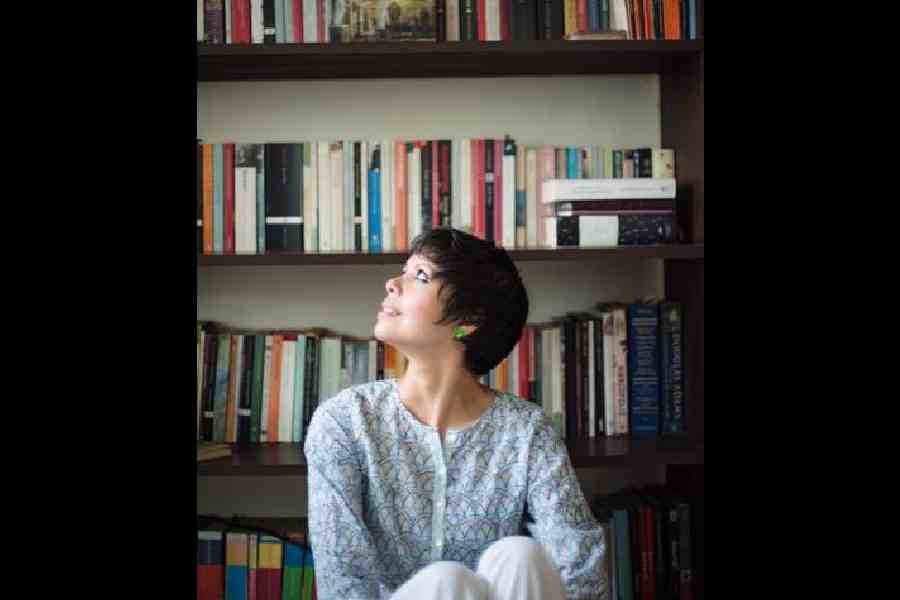It’s difficult to not feel chuffed when one finds a writer like Janice Pariat, who is flying with old ideas, but birthing them anew. After he won the Booker Prize for The Famished Road, author Ben Okri had said in an interview: “The world needs more happy stories that tell us about the magic of the forest.” On reading the foreword of Pariat’s novel, Everything the Light Touches (2022), the reader is struck with synchronicity. The pre-teen girl Mangoshi in Okri’s Every Leaf a Hallelujah (2021) finds echoes in Pariat’s character of the young woman Shai.
Okri had also said about Every Leaf a Hallelujah: “When I was growing up in Nigeria, the forest was all around us like a mother. I couldn’t have written this book without befriending a tree, a spiritual sponsor. I watched great lorries loaded with timber taking away the magical aspect of our lives. When I came back from my studies in England, the forest had vanished.”
A passage from Pariat’s novel similarly goes: “Listen, now, to how the tree, the tallest-in-the-world tree, was felled; how seven tribes were rendered earthbound; how its branches smacked the lands of the south, laying them flat and rich with the mulch of foliage, how the trunk crashed and carved our hills. Look how they bear the mark through all the ages still. Listen, listen, for a story told once may not be told again.”
If the aim of the story was to focus on nurturing nature, by contemplating on the root metaphor of the leaf, it might have been more strategic for Pariat to have stuck to that single theme and ejected some of the excess baggage at the drawing board. Uranium mining, destruction of trees, characters who belong to different geographies and historical timelines, and feminist meditations of a botanist from a previous century add to the two theoretical arguments by the 18th-century Swedish biologist Linnaeus and Pariat’s Goethe-like character Johann Philipp Möller. Often, the reader feels like a diner who has been overfed at a banquet of a hundred dishes. Some might feel the novel might have followed the lightness of light more attentively.

Author Janice Pariat with her book Everything the Light Touches
Pariat’s penchant for adopting the currently popular style of melding history with fiction is effective in the way that it makes theoretical ideas come alive through actual historical characters. This is a trend that has been successful with several authors: Salman Rushdie in Victory City, Anindyo Roy in The Viceroy’s Artist, and Amitav Ghosh in The Hungry Tide and Ghosh’s brilliant cache of fiction since have used the blending of the boundaries of fiction and history adeptly to signpost a nouvelle vague in the art of the postcolonial and postmodern novel.
In her invocation of Goethe, or Möller — his nom de plume as he journeyed in Italy in the 1780s — Pariat plays with fact and fiction. Pariat retraces Goethe’s footsteps as he fashions his ideas for The Metamorphosis of Plants, offering an amalgam of history, biography, philosophy and botany. “Leaf is not something still and static and clearly circumscribed,” Pariat’s Goethe argues, “it is dynamic, alive, it is always changing”.
Goete/Möller adds, “Hold back your theories! Let the phenomena speak for themselves!”
It seems Okri, once again, becomes the guide for many ecocritically-inclined novelists of the 21st century. In Everything the Light Touches, Pariat, who creates 30-something Shai, seems to have left a part of herself in the character. The power of faith in nature’s covenant of grace in light and leaf in Everything the Light Touches finds reverberations in the experiences of Okri’s seven-year-old Mangoshi, on a magic carpet ride to the wise and wonderful world of trees.
Today, ecocriticism is being used as a tool to wow the reader. Okri has been a strong proponent for 40 years and has been a powerful voice that inspires many writers today to be cheerleaders for biodiversity and sustainable development.
Every single incident or character in Pariat’s novel emanates from the idea of light through which the characters journey forth. And light becomes the medium and the message that illuminates the narrative.
Pariat says: “Since the book is largely concerned with an epistemological question — of how we come to learn about the world — and I used botany/science as a way to explore this philosophical question, it made sense for light to play that kind of shape-shifting role to encompass the many different themes the novel conjures: the light that fuels plants and, in turn, nourishes us, the light of knowledge, the light that shines on our faces, the ‘light’ of Christianity, the light of the stars.” The writer’s concept of light is spiritual and scientific. Every leaf, as she points out, is somehow related to light and the sustenance it provides.
About her unique vision of light, Pariat says: “I grew up in pockets of Assam and Shillong. So, one could say I was fortunate enough to inhabit beautiful places rooted in wildness and nature rather than in the city. I’m also quite a visual person and enjoy taking photographs. And when this is the case, you tend to be open and receptive to light and shadow.”
And about her book being about journeys, the author says: “My trip to Italy in early 2020 was where I travelled in Goethe’s footsteps through Rome. My journey to a garden in Salisbury in 2014, where I came across an exhibition on women Victorian botanists and the figure of Evie (one of the characters in her novel) began to grow in my head.”
The writer comes through as a dreamer, and keeps appearing and disappearing from the narrative. The author says: “I did the historical research first, and then wrote the book in various drafts over two-three years. It took a while, but I came to arrive at a point where I was certain it had to be these four characters, and these four journeys that the novel gently intertwines.”
Who are these four? The first is the young woman, Shai, who journeys to India’s Northeast to discover herself and has encounters with indigenous people. The second is Evelyn, a science student in Edwardian England, who is smitten by Goethe’s thoughts on plants and travels to the Himalayas. The third is Linnaeus, a botanist and taxonomist who goes on an expedition to Lapland in 1732. The fourth is Goethe, one of the greatest philosophers, who comes up with his ideas on plants when travelling through Italy in the 1780s. The four seem disconnected, but the novel unfolds to show the ways in which they are connected.
Of all the sections in the novel, where Pariat strategically showcases her ability to argue for many paths to reach a goal and show that in the diversity of perceptions there is still a planetary connect, it is perhaps her honest and unembellished creation of Shai’s mum Mei and Shai’s deep admiration and empathy for her father that makes the reader feel Pariat has delivered some priceless moments of luminosity. One example is the following passage:
His face brightens. “Fascinating, isn’t it?” I nod. This prompts him to chatter — about plant communication, their immense aromatic vocabulary, their capacity for memory.
“Birch trees can remember a past event for up to four years,” he says in delight.
Yes, I joke, it’s possible they have a better memory than I do.
Julie Banerjee Mehta is the author of Dance of Life, and co-author of Strongman: The Extraordinary Life of Hun Sen. She has a PhD in English and South Asian Studies from the University of Toronto, where she taught World Literature and Postcolonial Literature for many years. She currently lives in Calcutta and teaches Masters English at Loreto College
